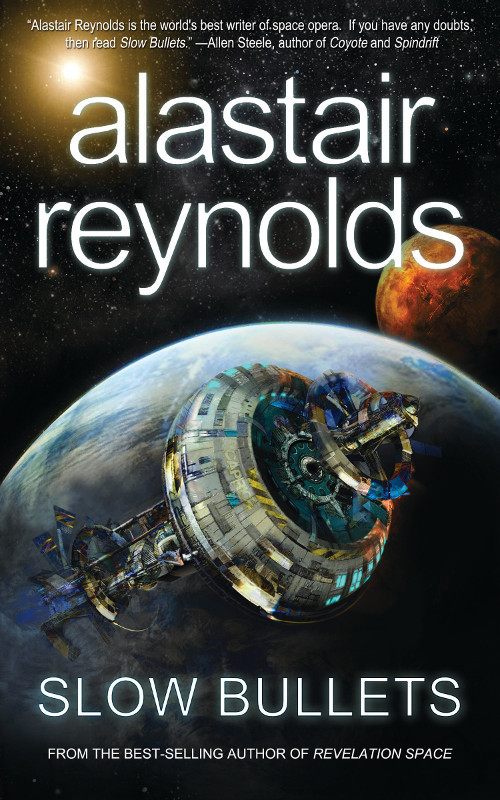The very solid SLOW BULLETS impresses

(Photo: Barbera Bella)
The positive reviews for Alastair Reynolds’ just released SLOW BULLETS come rolling in.
From VAL’S RANDOM COMMENTS:
The entire novella is told from the point of view of Scur, who is also the narrator of the story. What she is mostly concerned with, besides surviving, is passing on knowledge. The ship they are on is slowly losing memory. It contains a vast amount of knowledge. More than can possibly be stored by more old-fashioned means. How to survive is not the real dilemma she faces. They have more than enough resources for that. What to take with them is the real issue. These people are from a time when information is stored in huge quantities. All the soldiers on the ship carry a storage device in their body that registers their exploits. To be reduced to writing or rely on memory is to give up a large part of their past and identity. For Scur, who has accepted the fact that she will not return to her old home again, this is the ultimate sacrifice to be made for survival.
Reynolds raises an interesting point here. With our increasing reliance on digital data storage, several experts have been warning in recent years that we are facing a huge loss of data. How long before our CD-ROMs or DVDs no longer work? How long before the software to process them is no longer available for the newer machines? Digital storage has advantages, especially in terms of physical space required and the possibilities for quick data retrieval, but it is vulnerable in its own way. Then again, is it really so bad if we lose all the nonsense people are putting on their Facebook pages or Twitter feeds? Or the bazillion hazy holiday pictures quickly snapped with a crappy digital camera? Does losing that profoundly affect your identity? There is data and data, as Scur soon realizes. What to save when storage capacity is limited is another question that bugs Scur. Especially because the inhabitants of the space ship are from different worlds, with different world views and religions. A choice that is bound to cause conflict.
<snip>
SLOW BULLETS is a very enjoyable novella. Reynolds makes some bold choices over the course of the story and not everybody will like those. In the end I think it turned out quite well. The novella does not quite have the beauty of some of Reynold’s other novellas but in a way the rough structure fits the story. It is different enough from much of Reynolds’ other works that it will be interesting reading for people who have read his novels, but also contains enough recurring elements that to make it a decent entry point for new readers. It might not be the very best Reynolds has produced but it is not that far off either. You could do worse than pick up this novella.

Fans of Alastair Reynolds’ work will almost certainly enjoy SLOW BULLETS, but this would also be a good jumping on point for those who are new to the author. It isn’t set in one of his established settings and forms a self-contained and intriguing story that could well whet people’s appetites for more of his work.
Wow, I’ve never been as impressed with a sci-fi book as I was with this one. I blasted through it in one night because I just couldn’t bear to put it down!
<snip>
The book definitely made you think and ask yourself some difficult questions. Like if the only way you could record anything for prosperity was to etch it into the ship itself, what of your memories and knowledge would you choose to record in the limited time you had?
And if the only way to save important knowledge was to overwrite all written history of your past, would you be able to do it?
Like I said before, my only problem with this book was the fact that it was so short!! I’ve read on Goodreads that Scur appeared in another of Reynold’s books, so I may have to seek this out and read it very soon!
I think due to the fact that I felt some parts were hurried through and would have been improved by more detail, I can’t give this book a full 5/5, but it’s definitely a very solid 4.
For more about SLOW BULLETS, visit the Tachyon page.
Cover art by Thomas Canty.
Design by Elizabeth Story.
